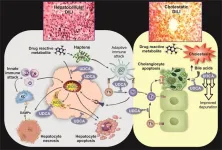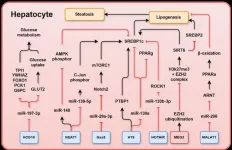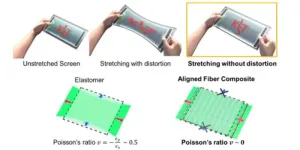(Press-News.org) A study led by UMass Chan researchers demonstrated that a gene therapy to correct a mutation that causes maple syrup urine disease (MSUD) prevented newborn death, normalized growth, restored coordinated expression of the affected genes and stabilized biomarkers in a calf as well as in mice.
“Simply put, we believe the gene therapy demonstrated in both animal species, especially in the cow, very well showcases the therapeutic potential for MSUD, in part because the diseased cow, without treatment, has a very similar metabolic profile as the patients,” said Dan Wang, PhD, assistant professor of genetic & cellular medicine.
Dr. Wang is co-principal investigator with Heather Gray-Edwards, DVM, PhD, assistant professor of genetic & cellular medicine; Guangping Gao, PhD, the Penelope Booth Rockwell Chair in Biomedical Research, director of the Horae Gene Therapy Center, director of the Li Weibo Institute for Rare Diseases Research and chair and professor of genetic & cellular medicine; and Kevin Strauss, MD, adjunct professor of pediatrics and head of therapeutic development at the Clinic for Special Children in Gordonville, Pennsylvania.
The study, published in Science Translational Medicine, was partially funded through an agreement with ASC Therapeutics, a privately held biopharmaceutical company developing in-vivo gene replacement, gene editing and allogeneic cell therapies.
MSUD is a rare genetic inborn error of metabolism characterized by recurrent life-threatening neurologic crises and progressive brain injury that can only be managed with an exacting prescription diet or liver transplant from a donor.
The condition occurs in one in 197,714 live births but is much more common in certain regions of Brazil, Portugal, Turkey, the Philippines, and among people of Ashkenazi or Mennonite descent. Among the Mennonite population such as communities in Lancaster County, Pennsylvania, the incidence of MSUD is one in 400.
MSUD is caused when a mutated form of the BCKDHA, BCKDHB or DBT gene is inherited from both parents. As a result of this mutation, the body is unable to break down certain parts of proteins. This leads to the build-up of toxic substances that can cause organ and brain damage.
Researchers in the current study designed a dual-function recombinant adeno-associated virus serotype 9 vector to deliver a gene replacement to the liver, muscle, heart and brain. They wrote that the one-time treatment holds promise as a therapeutic alternative to prescription diet and liver transplant for treatment of MSUD types 1A and 1B, the two most common forms of MSUD in humans.
Data from the calf translated more directly to humans for purposes of understanding pharmacokinetics, specific treatment effects on muscle and brain tissue, and long-term durability through an extended phase of growth.
"We believed gene therapy could be a breakthrough for patients with MSUD and, in August 2018, met on a cattle farm in Iowa to pursue that vision: to develop and test gene therapy in a unique animal model, a newborn calf with MSUD,” said Dr. Strauss. “In the years that followed, physicians at the Clinic for Special Children worked intently with scientists and veterinarians from UMass Chan Medical School to achieve that goal, drawing their inspiration from the hopes and struggles of the MSUD community. For people worldwide living with MSUD, this signifies major progress on the path to a brighter future."
Wang said that researchers are exploring with the U.S. Food and Drug Administration the next steps to translate this gene therapy into clinical use as a Phase I/II study.
END
Gene therapy developed for maple syrup urine disease shows promise, new UMass Chan study reports
2025-02-28
ELSE PRESS RELEASES FROM THIS DATE:
Ursodeoxycholic acid for the management of drug-induced liver injury: Role of hepatoprotective and anti-cholestatic mechanisms
2025-02-28
Drug-induced liver injury (DILI) is a significant concern in clinical practice, arising from medications, herbs, and dietary supplements. It can manifest in different forms, including hepatocellular, cholestatic, and mixed types, each associated with specific liver enzyme abnormalities and histological injury patterns. Hepatocellular DILI is characterized by inflammation, necrosis, and apoptosis, while cholestatic DILI involves bile plug formation and bile duct paucity. Ursodeoxycholic acid (UDCA), a widely used treatment for cholestatic liver diseases, has recently been investigated for its potential therapeutic effects ...
Hepatic biliary adenofibroma: Histological characteristics, diagnostic challenges, and its role as a precursor to intrahepatic cholangiocarcinoma
2025-02-28
Hepatic biliary adenofibroma (BAF) is a rare benign bile duct neoplasm that has garnered increasing attention due to its potential role as a precursor lesion for intrahepatic cholangiocarcinoma (iCCA). Although it shares histopathological features with other biliary tumors, BAF is distinct in its composition, consisting of low-grade tubuloglandular and microcystic bile duct structures embedded in a dense fibrous stroma. Despite its classification as a benign tumor, emerging case reports suggest that BAF may undergo malignant transformation. However, its rarity and limited molecular characterization contribute to diagnostic ...
Unlocking the role of long non-coding RNAs in liver disease progression
2025-02-28
Metabolic dysfunction-associated steatotic liver disease (MASLD), formerly known as non-alcoholic fatty liver disease (NAFLD), is a global health challenge, affecting nearly 30% of adults worldwide. A significant subset of MASLD patients progresses to metabolic dysfunction-associated steatohepatitis (MASH), liver fibrosis, and even hepatocellular carcinoma (HCC), yet no universally approved treatment exists outside resmetirom. The increasing prevalence of MASLD, driven by obesity and diabetes, highlights an urgent need for innovative therapeutic ...
McMaster researchers uncover blood metabolites that may influence early childhood development
2025-02-28
McMaster University researchers have identified small molecules in the blood that may impact early childhood development, showing how dietary exposures, early life experiences, and gut health can influence a child's growth and cognitive milestones.
A McMaster team collaborated with Brazilian scientists to conduct an untargeted metabolomic analysis of blood samples taken from more than 5,000 children between the ages of six months and five years as part of the Brazilian National Survey of Child Nutrition study.
The McMaster team found several metabolites – small molecules that are by-products of human metabolism and microbial fermentation, ...
Why don’t pandas eat more meat? Molecules found in bamboo may be behind their plant-based diet
2025-02-28
Giant pandas have digestive systems that are typical for carnivores. Yet, bamboo is their main source of food. They have evolved several features, for example pseudo thumbs to grasp bamboo and flat teeth that are well suited for crushing it, that make it possible for them to live off plants.
All living organisms have DNA, which stores the genetic information in a cell, and RNA, which carries and transfers this information. MicroRNAs (miRNA) are small non-coding RNAs that play an important role in gene expression, the process of turning the information encoded in a gene into a function. ...
Development of 'transparent stretchable substrate' without image distortion could revolutionize next-generation displays
2025-02-28
Stretchable display materials, which are gaining traction in the next-generation display market, have the advantage of being able to stretch and bend freely, but the limitations of existing materials have resulted in distorted screens and poor fit. General elastomeric substrates are prone to screen distortion due to the 'Poisson's ratio' phenomenon, in which stretching in one direction causes the screen to shrink in the vertical direction. In particular, electronics that are in close contact with the skin, such as wearable devices, are at risk of wrinkling or pulling on the skin during stretching and shrinking, resulting in ...
Improving the scope of wearable monitors
2025-02-28
By Alistair Jones
SMU Office of Research – Even by the standards of medical terminology, photoplethysmography (PPG) is a mouthful. Yet it is widely used in clinical settings as a non-invasive, optical technique for measuring the oxygen saturation level in the blood, and the pulse rate, as vital signs of a patient. It is commonly encountered as a clip-on oximeter attached to a finger.
First developed in the 1930s, PPG emits light to illuminate the microvascular bed of the skin. Then a photodiode, positioned alongside the light emitter, captures the reflected light, termed the PPG waveform, which ...
Zeroing in: SMU project to boost indoor localization capabilities for the public agencies
2025-02-28
By Vince Chong
SMU Office of Research – With the surfeit of trackable, wearable devices in modern life, there is little problem locating things and people outdoors by leveraging Global Navigation Satellite System (GNSS) solutions (GPS is an example of this type of solution) that use signals from satellites. Indoors on the other hand, is a different matter as GNSS signals are unavailable and other possible signals such as those from Wi-Fi systems are inconsistent, and often distorted.
And when this ability to swiftly, accurately locate indoor objects is starkly crucial to essential services that make the difference between life and death, upgrading ...
E. coli strain in Egyptian dairy products also found in Japan school outbreak
2025-02-28
No one should have to fear food poisoning every time they eat or drink, but the reality, even in the 21st century, is that risks remain. An Osaka Metropolitan University-led Egypt-Japan research team found E. coli prevalent in over 25% of popular milk and dairy products in Egypt.
Of the 210 samples of raw milk, cheese, and yoghurt, 26.2% were positive for E. coli, with the highest being raw buffalo milk at 68%, and the lowest at 7.5% for rayeb, a type of fermented milk. The preference for raw milk instead of pasteurized milk and varying hygienic conditions at small dairies and markets could explain these results. Yet food poisoning ...
Quantum computing “a marathon, not a sprint”
2025-02-28
By Christie Loh
SMU Office of Research – When his parents heard that he had won an award at his workplace, they were naturally delighted, showering their son with a confetti of questions like what the prize was for, whether there was a formal ceremony, and that he must keep up the good work. Indeed, Monit Sharma is well aware that as encouraging as the SMU Research Staff Excellence Award is, the professional road he is on calls for both hard work and stamina.
The 23-year-old is a Research Engineer at SMU’s ...







